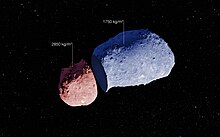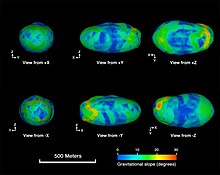
Vesta is one of the largest objects in the asteroid belt, with a mean diameter of 525 kilometres (326 mi). It was discovered by the German astronomer Heinrich Wilhelm Matthias Olbers on 29 March 1807 and is named after Vesta, the virgin goddess of home and hearth from Roman mythology.

Hayabusa was a robotic spacecraft developed by the Japan Aerospace Exploration Agency (JAXA) to return a sample of material from a small near-Earth asteroid named 25143 Itokawa to Earth for further analysis. Hayabusa, formerly known as MUSES-C for Mu Space Engineering Spacecraft C, was launched on 9 May 2003 and rendezvoused with Itokawa in mid-September 2005. After arriving at Itokawa, Hayabusa studied the asteroid's shape, spin, topography, color, composition, density, and history. In November 2005, it landed on the asteroid and collected samples in the form of tiny grains of asteroidal material, which were returned to Earth aboard the spacecraft on 13 June 2010.

1862 Apollo is a stony asteroid, approximately 1.5 kilometers in diameter, classified as a near-Earth object (NEO). It was discovered by German astronomer Karl Reinmuth at Heidelberg Observatory on 24 April 1932, but lost and not recovered until 1973.

2867 Šteins is an irregular, diamond-shaped background asteroid from the inner regions of the asteroid belt, approximately 5 kilometers in diameter. It was discovered on 4 November 1969 by Soviet astronomer Nikolai Chernykh at the Crimean Astrophysical Observatory in Nauchnij on the Crimean peninsula. In September 2008, ESA's spacecraft Rosetta flew by Šteins, making it one of few minor planets ever visited by a spacecraft. The bright E-type asteroid features 23 named craters and has a rotation period of 6.05 hours. It was named for Soviet Latvian astronomer Kārlis Šteins.
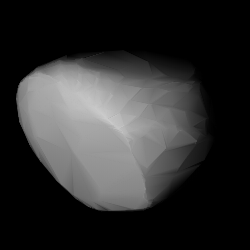
1036 Ganymed, provisional designation 1924 TD, is a stony asteroid on a highly eccentric orbit, classified as a near-Earth object of the Amor group. It was discovered by German astronomer Walter Baade at the Bergedorf Observatory in Hamburg on 23 October 1924, and named after Ganymede from Greek mythology. With a diameter of approximately 35 kilometers, Ganymed is the largest of all near-Earth objects but does not cross Earth's orbit. The S-type asteroid has a rotation period of 10.3 hours. In October 2024, it is predicted to approach Earth at a distance of 56,000,000 km; 35,000,000 mi (0.374097 AU).

4660 Nereus, provisional designation 1982 DB, is a small asteroid. It was discovered by Eleanor F. Helin on 28 February 1982, approximately a month after it passed 4.1 million km (11 LD) from Earth.

Massalia, minor planet designation 20 Massalia, is a stony asteroid and the parent body of the Massalia family located in the inner region of the asteroid belt, approximately 145 kilometers in diameter. Discovered by Italian astronomer Annibale de Gasparis on 19 September 1852, it was named for the French city of Marseille, from which the independent discover Jean Chacornac sighted it the following night. It was the first asteroid that was not assigned an iconic symbol by its discoverer.
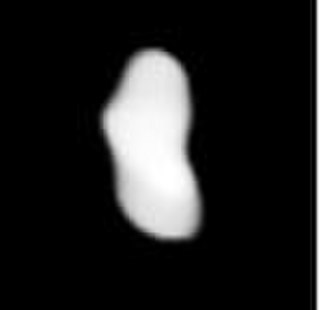
Ausonia is a stony Vestian asteroid from the inner region of the asteroid belt, approximately 100 kilometers in diameter. It was discovered by Italian astronomer Annibale de Gasparis on 10 February 1861, from the Astronomical Observatory of Capodimonte, in Naples, Italy. The initial choice of name for the asteroid was "Italia", after Italy, but this was modified to Ausonia, an ancient classical name for the Italian region.
Hamburga is a carbonaceous asteroid from the background population of the intermediate asteroid belt, approximately 75 kilometers in diameter. It was discovered by German astronomers Max Wolf and Friedrich Schwassmann at Heidelberg Observatory on 31 October 1899, and later named after the city of Hamburg in Germany.

Space weathering is the type of weathering that occurs to any object exposed to the harsh environment of outer space. Bodies without atmospheres take on many weathering processes:

Extraterrestrial material refers to natural objects now on Earth that originated in outer space. Such materials include cosmic dust and meteorites, as well as samples brought to Earth by sample return missions from the Moon, asteroids and comets, as well as solar wind particles.

1580 Betulia, provisional designation 1950 KA, is an eccentric, carbonaceous asteroid, classified as near-Earth object of the Amor group, approximately 4.2 kilometers in diameter. It was discovered on 22 May 1950, by South African astronomer Ernest Johnson at the Union Observatory in Johannesburg. The asteroid was named for Betulia Toro, wife of astronomer Samuel Herrick.

1980 Tezcatlipoca, provisional designation 1950 LA, is an eccentric, stony asteroid and near-Earth object of the Amor group, approximately 6 kilometers (4 mi) in diameter.

101955 Bennu (provisional designation 1999 RQ36) is a carbonaceous asteroid in the Apollo group discovered by the LINEAR Project on 11 September 1999. It is a potentially hazardous object that is listed on the Sentry Risk Table and has the highest cumulative rating on the Palermo Technical Impact Hazard Scale. It has a cumulative 1-in-1,750 chance of impacting Earth between 2178 and 2290 with the greatest risk being on 24 September 2182. It is named after Bennu, the ancient Egyptian mythological bird associated with the Sun, creation, and rebirth.
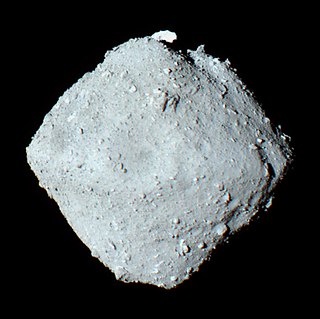
162173 Ryugu (provisional designation 1999 JU3) is a near-Earth object and a potentially hazardous asteroid of the Apollo group. It measures approximately 900 metres (3,000 ft) in diameter and is a dark object of the rare spectral type Cb, with qualities of both a C-type asteroid and a B-type asteroid. In June 2018, the Japanese spacecraft Hayabusa2 arrived at the asteroid. After making measurements and taking samples, Hayabusa2 left Ryugu for Earth in November 2019 and returned the sample capsule to Earth on 5 December 2020. The samples showed the presence of organic compounds, such as uracil (one of the four components in RNA) and vitamin B3.

A planetary surface is where the solid or liquid material of certain types of astronomical objects contacts the atmosphere or outer space. Planetary surfaces are found on solid objects of planetary mass, including terrestrial planets, dwarf planets, natural satellites, planetesimals and many other small Solar System bodies (SSSBs). The study of planetary surfaces is a field of planetary geology known as surface geology, but also a focus on a number of fields including planetary cartography, topography, geomorphology, atmospheric sciences, and astronomy. Land is the term given to non-liquid planetary surfaces. The term landing is used to describe the collision of an object with a planetary surface and is usually at a velocity in which the object can remain intact and remain attached.
Asteroidal water is water or water precursor deposits such as hydroxide (OH−) that exist in asteroids. The "snow line" of the Solar System lies outside of the main asteroid belt, and the majority of water is expected in minor planets. Nevertheless, a significant amount of water is also found inside the snow line, including in near-earth objects (NEOs).

Dimorphos is a natural satellite or moon of the near-Earth asteroid 65803 Didymos, with which it forms a binary system. The moon was discovered on 20 November 2003 by Petr Pravec in collaboration with other astronomers worldwide. Dimorphos has a diameter of 177 meters (581 ft) across its longest extent and it was the target of the Double Asteroid Redirection Test (DART), a NASA space mission that deliberately collided a spacecraft with the moon on 26 September 2022 to alter its orbit around Didymos. Before the impact by DART, Dimorphos had a shape of an oblate spheroid with a surface covered in boulders but virtually no craters. The moon is thought to have formed when Didymos shed its mass due to its rapid rotation, which formed an orbiting ring of debris that conglomerated into a low-density rubble pile that became Dimorphos today.

Space dust measurement refers to the study of small particles of extraterrestrial material, known as micrometeoroids or interplanetary dust particles (IDPs), that are present in the Solar System. These particles are typically of micrometer to sub-millimeter size and are composed of a variety of materials including silicates, metals, and carbon compounds. The study of space dust is important as it provides insight into the composition and evolution of the Solar System, as well as the potential hazards posed by these particles to spacecraft and other space-borne assets. The measurement of space dust requires the use of advanced scientific techniques such as secondary ion mass spectrometry (SIMS), optical and atomic force microscopy (AFM), and laser-induced breakdown spectroscopy (LIBS) to accurately characterize the physical and chemical properties of these particles.
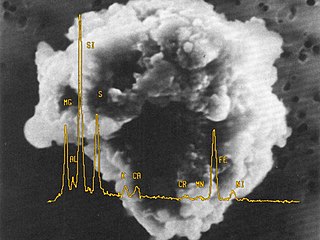
Dust astronomy is a subfield of astronomy that uses the information contained in individual cosmic dust particles ranging from their dynamical state to its isotopic, elemental, molecular, and mineralogical composition in order to obtain information on the astronomical objects occurring in outer space. Dust astronomy overlaps with the fields of Planetary science, Cosmochemistry, and Astrobiology.



